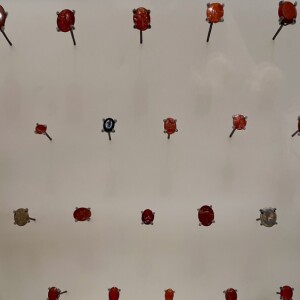Hypocaust
We have followed the wonderful discovery of the remains of a Roman bathhouse in Stanwix, Carlisle from when it was first discovered at Carlisle Cricket Club in 2017. We visited the excavation site then and have been several times since to see how the dig was developing. Now there is an exhibition in Tullie House - Digging Deeper, Uncovering Roman Carlisle. This showcases some of the incredible finds from the bathhouse, e.g. the huge stone heads (see first extra), which many people will recognise as these finds made the news. But the exhibition also provides a context, for example there is a film of the site seen from the air - all the digging and finding actually going on. Much of the digging was done by volunteers and we get to hear their views of the work. An excellent exhibition, well worth visiting - I think it is on until the middle of next month.
So, a few highlights of the exhibition
Hot Air
My blip is a pile of tiles - not just any old tiles but Roman Hypocaust tiles. As soon as these started to be unearthed, archaeologists knew that this was once a building of great importance. The tiles created a structure of columns on which the floor rested. Hot air was circulated below and so the bathhouse was heated. Only buildings of high status had such a system. Thoughts are at the moment that this bathhouse was a grand public building sited as it was on the frontier zone of the Roman Empire.
From a drain
I was very taken with the Intaglios, tiny carved pieces of semi-precious stone that would sit in a fitting in a finger ring. Incredible how tiny these are and how intricate the designs. Around 70 of these have been found, making it the most important collection of Roman gems in Britain, if not the whole Empire. Very hard to photograph as they are so tiny and behind glass (see second extra). I have included (third extra) a copy of the front cover of a lovely book which I bought, which shows them much more clearly. So, why were there so many found here in the bathhouse drain? The answer seems to be that people would have had rings on whilst visiting the bathhouse, not realising that the warm water was likely to expand the metal and loosen the adhesive attaching the gems from the settings and so allowing many to be lost . . . down the drain!




Comments
Sign in or get an account to comment.


